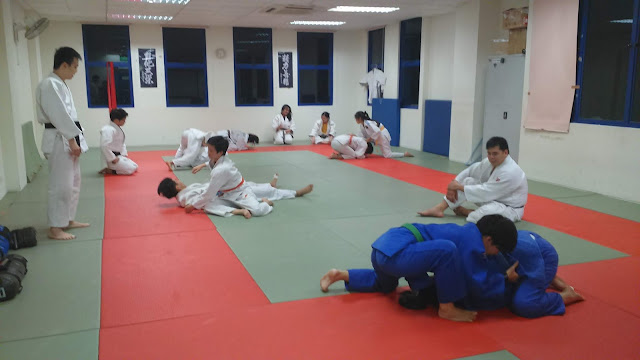 |
| Drills are crucial for developing competition skills. |
How do you prepare your players for competition if they don't have a lot of training partners to randori with and when there are not a lot of competitions around? The answer is: Drills and Shiai.
If you have a situation where there are 50 players on the mat doing daily randori for two hours every day, you don't need to do drills. In the course of doing those many hours of randori with a wide range of partners, each player would have come up with all kinds of situations. If they do this for a prolonged period of time, they would become capable of dealing with different types of opponents and can deal with different kinds of scenarios.
In contrast, if you have only a handful of players who spar with the same partners over and over again, they become used to the fighting styles of their partners. Over time, they become very good at fighting against those type of styles -- but only those type. They won't be used to fighting other styles because their exposure is limited.
For example, let's say you only have four people training regularly and all four are right-handers. These players would be familiar with fighting right-handers but not left-handers. Or let's say all four don't particularly like to do groundwork. Just training with each other will not prepare them for a match against a groundwork specialist.
When you have 50 players on the mat, all of them black belts, it's a different story. You will be forced to fight all kinds of styles, right-handers, left-handers, people who like groundwork, people who don't, etc.
In Japan, they do tons of randori. It's not unusual for a randori session to go on for two hours and players get between 10 to 15 rounds of randori each session. That's not possible in most clubs around the world. There simply aren't enough players.
So what you can do if you only have a small group is to have them do situational drills. These are drills that simulate or mimic a particular scenario: a left-handed high gripper, for example. Let's say the players are all right-handed. The only way you can prepare for them to fight a leftie with a penchant for high grips is to get the players you have to simulate such a situation and get each of them to try fending off that grip and imposing their own grip. This would not naturally happen in a randori situation because none of them is left-handed in the first place.
There are not a lot of competitions in Malaysia or in our neighboring countries. The lack of competition opportunities can be offset by having your own little shiais in the dojo. These are more focused and intense than regular randori where players fight each other as if they were in competition. It's still not quite the same as taking part in actual competitions but it more closely resembles a competition situation than regular randori. Shiais take up a lot of time because you can only have two people doing it at a time. But they are worth doing because only doing drills and randori is simply not enough.
We are a small club. As such we will be doing more drills and shiais in the weeks and months to come as we prepare our players for competitions in the second half of the year.
No comments:
Post a Comment